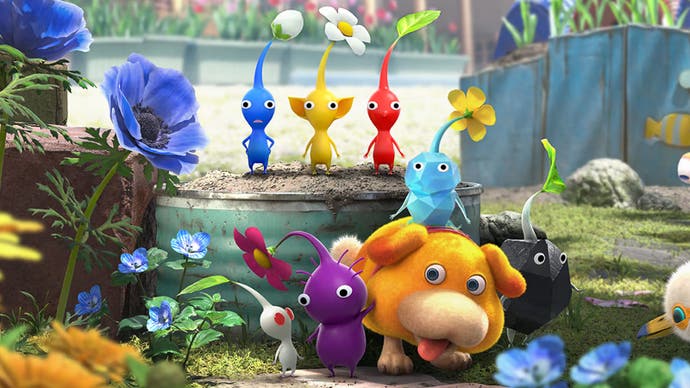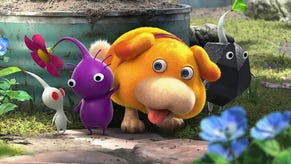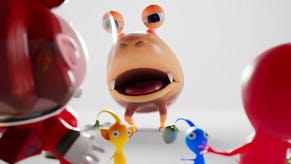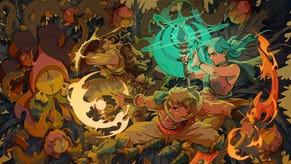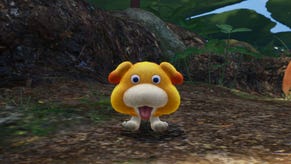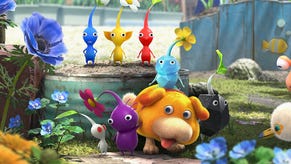Pikmin 4 review - Nintendo's oft-overlooked garden strategy reaches near-perfect evolution
Trowel and error.
I've always loved the Pikmin series' setting, and the suggestion that these tiny creatures are hiding somewhere out there in our world, overlooked but only just out of sight. And I love the idea that despite living around us, in our homes and gardens, between mud-caked plant pots and heavy-headed dandelions, that Pikmin require people with a slightly different - indeed, alien - point of view to uncover them, spend time with them, and realise their true worth.
It's a feeling I think reflects attitudes to the often slightly-overlooked Pikmin series overall, despite several major incarnations, re-releases, spin-offs, and promotion from the legendary Shigeru Miyamoto himself. In terms of sales it has never troubled the likes of Splatoon or Luigi's Mansion, let alone Mario or Zelda. It's something of an oddball concept, with a cutesy strategy wrapper that hides decidedly more hardcore demands of resource and time management. And while its characters look good as soft toys, I wonder how many plushie owners actually slogged it through to 100 percent Pikmin 3. Perhaps it's bad luck? Until now, Nintendo has unfortunately always planned new Pikmin entries for its hardware generations that underperformed. Or perhaps, despite repeatedly coming close, Nintendo has simply never quite cracked a formula that works for a wide audience. Well, after experiencing the sheer wealth on offer in Pikmin 4, I'm not sure what else Nintendo can try.
With brilliant results, Pikmin 4 acts both as the perfect entry point into this world and as an extremely well-examined follow-up for long-time fans who've waited a decade for Nintendo to nail this next chapter. A good example of this is Oatchi, the game's new canine co-protagonist, who I started off feeling distinctly ambivalent about. As anyone who's played Pikmin 4's demo will know, the game starts with the gentlest of ramps up to the series' usual requirements of dividing your time and resources among different Pikmin types and different human (now, also spacedog) leaders. Division of labour is a key component of the series that has evolved over time, and it elevated Pikmin 2 from its solo-protagonist predecessor. But things went too far in Pikmin 3, where control of three protagonists via the Wii U's GamePad tablet took an awkward swing towards RTS territory.
Back to Oatchi. Let's be real here: the dog looks good on the game's box. To newcomers, he's a welcoming face and his role as a mount for your avatar to ride is instantly understood. To those who've stepped foot on planet PNF-404 before, he's obviously your second leader and you quickly gain the ability to divide and control your Pikmin troops between your avatar and him. So, for those who want to play Pikmin 4 as Pikmin 2, switching between characters constantly for maximum strategic advantage, you can do so. For those who want to play akin to Pikmin 3, and set markers on the game's map to lay paths for a leader to follow while you're busy elsewhere, you can do that too. For those who want to play as Pikmin 1, even, and just use your avatar as a solo main character, I can count the number of times Pikmin 4 forces you to play separately as Oatchi on one hand.
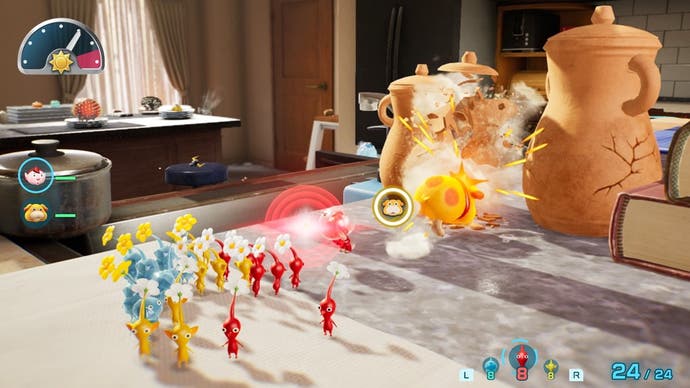
As the hours pass and the game unfurls, Pikmin 4 pays back your patience with layer upon layer of further abilities, upgrades and fresh gameplay types to enjoy, each dovetailing into another. For example, progression through the game's timed challenges and fun night-time missions will unlock upgrades to Oatchi's abilities, nudging you towards different gameplay approaches and welcome ease-of-life upgrades in order to explore further and take on tougher challenges. The ability to recall stray Pikmin at the touch of a button once you've bought a particular upgrade is a welcome late-game addition - though I can see some Pikmin purists opting not to use it. Pikmin 2's character upgrades also return - giving you a reason to go hunting for crystal-like resources alongside the traditional human objects lying around as treasures. Lastly, the triumphant return of Pikmin 2's caves - and their increasing difficulty - allows you to spend more and more time strategising encounters in often claustrophobic locales, free of the game's usual time limit found on the planet's surface.
The game's same rewarding pace is kept for the rollout of Pikmin themselves, whose typical type-by-type introduction is naturally elongated here by the fact Pikmin 4 makes sure to include every major type featured across the series to date (Pikmin 3's relegation of Purple and White to side-modes continues to sting). There's even a gradual pace to how large your squad can grow - and I didn't hit the usual total of 100 Pikmin until after the game's first ending. In short, it means you get plenty of time with the series' basic Red and Yellow types, the former of which now has the additional ability of being able to carry fire, before you move on to explore each area's underwater areas with Blue Pikmin.

Pikmin 4's all-new Ice Pikmin are also introduced early on, and are a smart addition. The ability to solidify water sources offers intriguing alternatives to certain combat situations, though they are most useful for temporarily freezing foes solid mid-attack, something that greatly aids your ability to whittle down enemy health in relative safety. This is something of a replacement for Pikmin 2's Ultra Bitter Spray, now with a trade-off: that frozen enemies shatter on defeat, robbing you of valuable resources. Ultimately, I found myself freezing enemies only when necessary, or attempting a nimble retreat when an enemy was low on health so it could thaw and then be defeated (and harvested) via non-frozen means.
The game's other new species, Glow Pikmin, are encountered exclusively in night missions, and are the only type of Pikmin used in these separate sections. Pikmin 4's after-dark sojourns have been kept mysterious by Nintendo but amount to quickfire tower defence distractions where you must build a Pikmin army at pace then protect a series of hives until morning comes. The ghostly Glow Pikmin can be grown and put to work far faster than normal, and warp back to you once an activity is complete. They can also combine together into a giant orb for a powerful charged attack. Like all of the game's secondary gameplay sections, its night missions - and Glow Pikmin - crucially also feed back into the game's main campaign: here, by providing you with Glow Pikmin seeds for use in underground environments. These seeds allow you to call upon Glow Pikmin you've previously created for use as temporary support underground - handy if you have lost Pikmin from your squad mid-cave. Again, there's a trade-off: similar to Pikmin 2's much-missed Bulbmin, you'll leave them behind when exiting the dungeon.
While night missions are brief, they act as one of several palate cleansers you can access at any time from Pikmin 4's new hub, where you begin each in-game day. It's here that you're able to spend resources on upgrades before striking out on your next expedition, or choose to replay challenge levels for better scores, or simply just natter with some of the many other faces you encounter on your travels. Pikmin 4's story is as straightforward as any Miyamoto game, though there's a real depth to its background and some pleasing joining of the dots between past Pikmin games to uncover for fans. Your growing encampment also allows you to check in your treasure collection, and keep up to date with a laundry list of side-missions that will propel you back into previous areas.

The game's initial story - where you and a rescue squad of NPCs seek out the original Pikmin protagonist Captain Olimar - culminates in a series standout area based inside a human house for the first time - and it's a real thrill to be commanding a sea of Pikmin as you scuttle over the carpet and dart underneath sofas, before climbing up kitchen cupboards and across the roaring fire of a kitchen hob. In large areas such as this, I appreciated the new ability to move your landing zone and Pikmin Onion to different places, cutting down on the need for backtracking.
Pikmin purists might initially raise eyebrows at the game's new limit of three Pikmin types in your squad at one time (although you can get around this in caves), but again, over time I got what the game was going for, and found this actually aided areas in being more focused, while still allowing you to use any of the game's main daytime Pikmin varieties at any time. A brilliant and rather beautiful mid-game beach area is a good example of this focus, where as you might expect, the aquatic Blue Pikmin get a real chance to shine. But even here there's variety - half-way through each in-game day, the tide will recede and more land is uncovered.
It's in the game's later areas you'll encounter the hefty Purple, angular Rock and airborne Flying Pikmin varieties from past games - while uncovering the series' White breed took me even longer (although once uncovered, there's perhaps more here for them to do in Pikmin 4 than ever before). Nintendo is keen that Pikmin 4 reviews do not spoil how much the game has to offer after your initial quest comes to something of a conclusion - a point at which the game's main credits roll. I'll simply say that this is a very, very generous game, that fans of both Olimar and Pikmin 1 in particular will be happy, and that my playtime since that point has more than doubled.
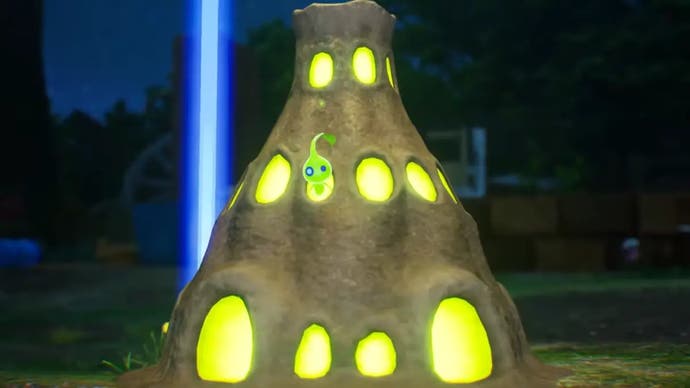
I could go on and on about how well Pikmin 4's parts slowly come together, how your hub fills with extra things to do, the entire "Dandori" challenge mode where you fight against AIs or against a time limit to gather resources against the clock, the proper return of the Piklopedia, the small tweaks to established gameplay that make this game such as step forward in dozens of small ways (but what a pleasure lock-on targeting is). Then there's the game's rewind feature, which quickly became a necessity for me to try and limit Pikmin suffering, but which I simultaneously believe also allows the game to constantly offer more surprises and tougher battles knowing you have a Get Out Of Jail Free card when things go wrong, rather than making you grinding for more Pikmin to replace lost numbers.
Pikmin 4 fills itself and your time with a rich array of things to do, things to find, goals to chase and places to explore. It may start slow, but when it all comes together, it really does sing. It preserves the series' oddities - it doubles down on them in some regards - and yet opens the series up in a way Pikmin has never managed previously. It's a fine reward for a decade of fan patience and a lot of thought by Nintendo's top brass on how best to continue after Pikmin 3. It's a skillful evolution of a series which has been left feeling a little overlooked for too long. Is this Pikmin's true breakthrough moment? Who knows. But without a doubt it's one of Nintendo's best games in years.
